Experimental Study on Seismic Behavior of Precast Bolt-Connected Steel-Members End-Embedded Concrete (PBSEC) Beam-Column Connections
Abstract
1. Introduction
- The structure is simple, and the force path is clear. Changing the thickness of the connecting steel plate can realize the controllable stiffness of the joint to optimize the structure’s seismic performance and repair the performance after structural damage by replacing the connecting steel plate;
- The damage to the structure is controllable. When the structure is subjected to an earthquake, the connecting steel plates of the joints resist the bending moment caused by the earthquake, while the beams and columns are still in an elastic state. When the connecting steel plate yields, the stiffness of the joint changes from semi-rigid characteristics to zero, which can be regarded as a hinge, the structure is in the ideal state of the hinged beam end, and the seismic capacity and collapse resistance of the structure is improved;
- There is no wet operation in the assembly process, and the all-dry construction method is adopted. The beams and columns are assembled with high-strength bolts during construction. There is no need to pour concrete and support formwork throughout the process, significantly improving construction efficiency.
2. Design of the Test Specimens
3. Processing of the Test Specimens
3.1. Manufacturing Process
3.2. Material Properties
4. Test Loading and Measurement Scheme
4.1. Test Loading Device
4.2. Test Procedure and Measurements
5. Analysis of the Test Results
5.1. Observations and Failure Modes
5.2. Strain–Displacement Curves
5.3. Hysteresis and Skeleton Curves
5.4. Evaluation of the Performance Indicators
5.4.1. Average Peak Load
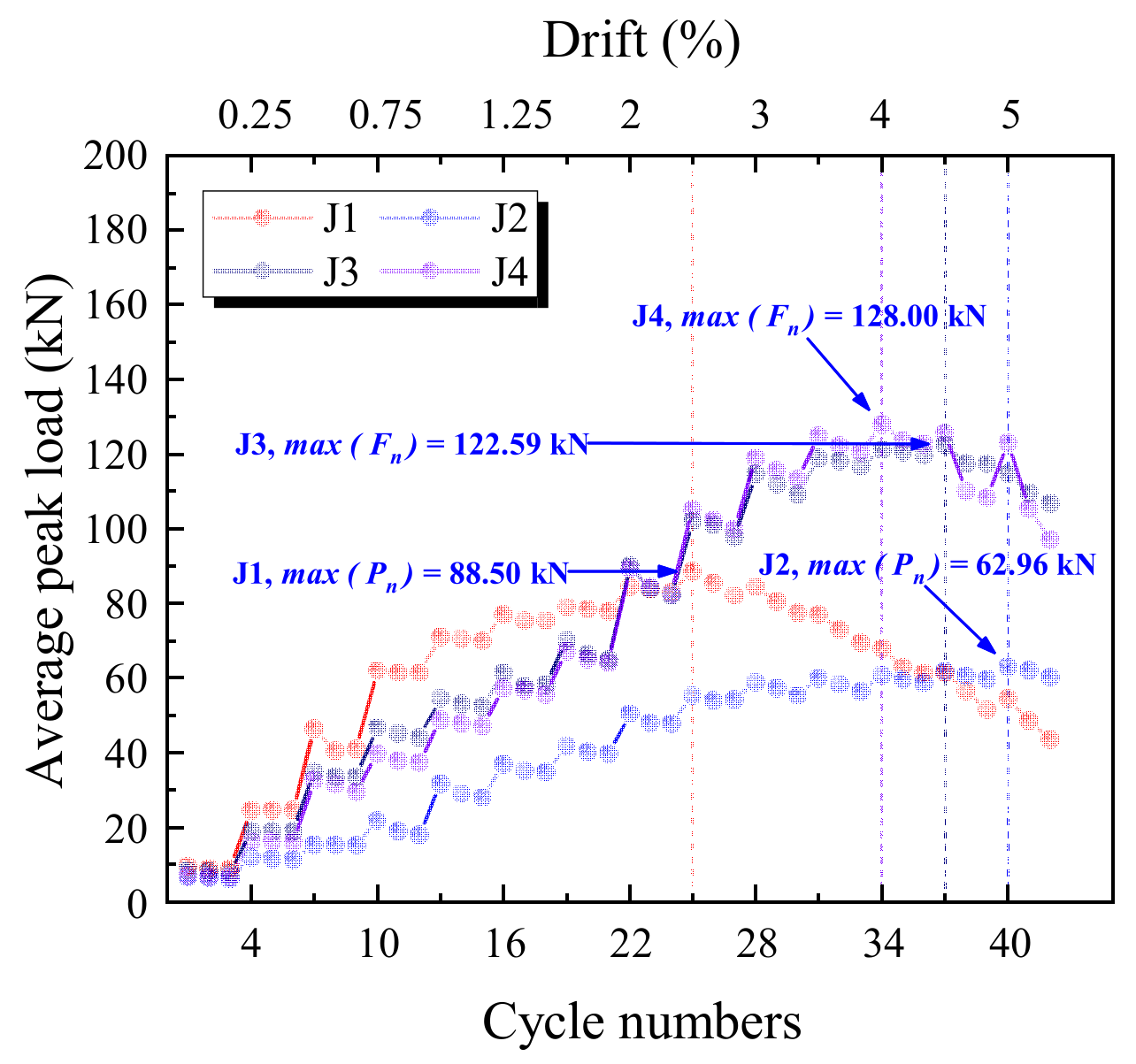
5.4.2. Strength Degradation Ratio
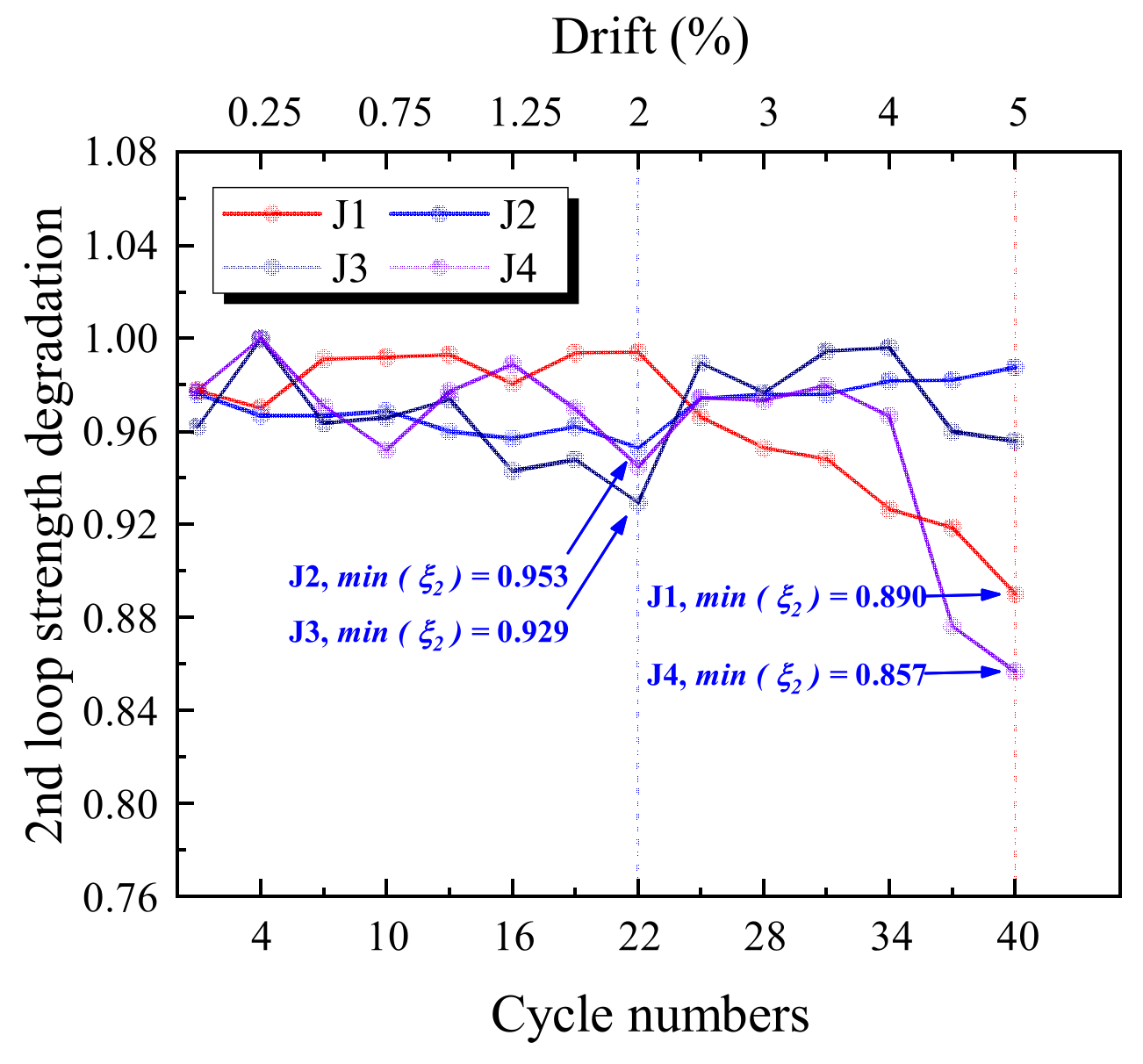

5.4.3. Energy Dissipation Indicators
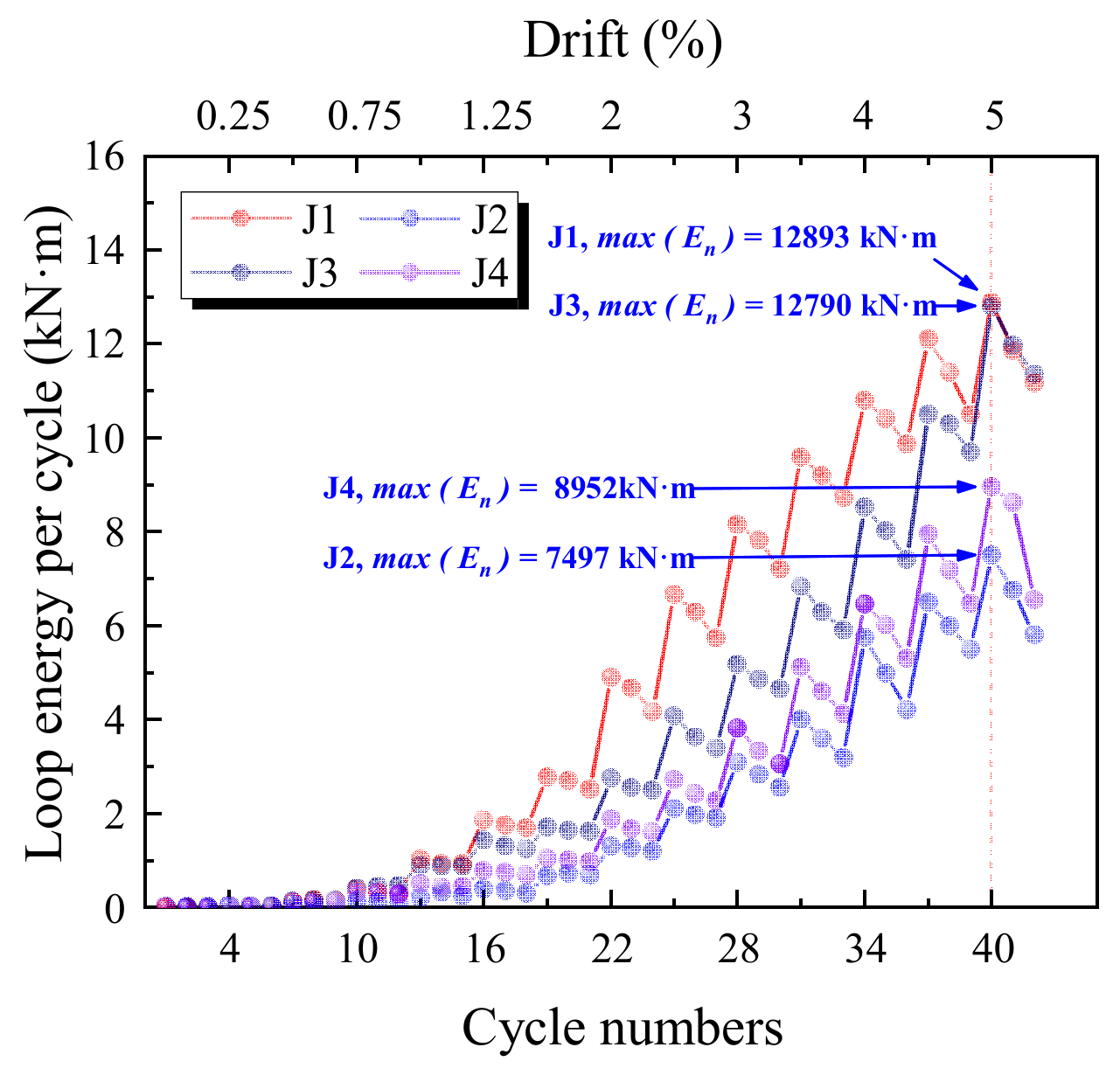

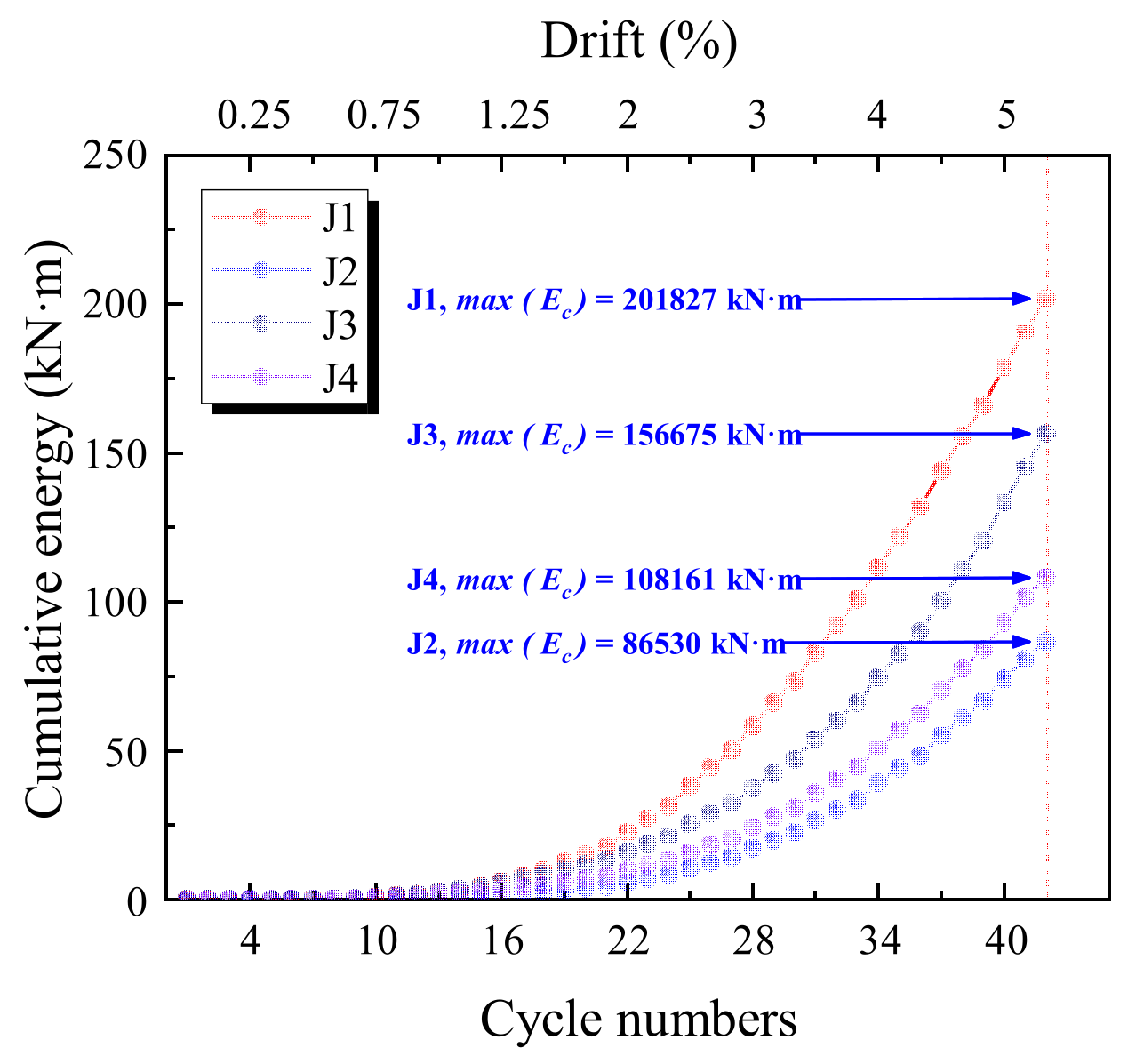
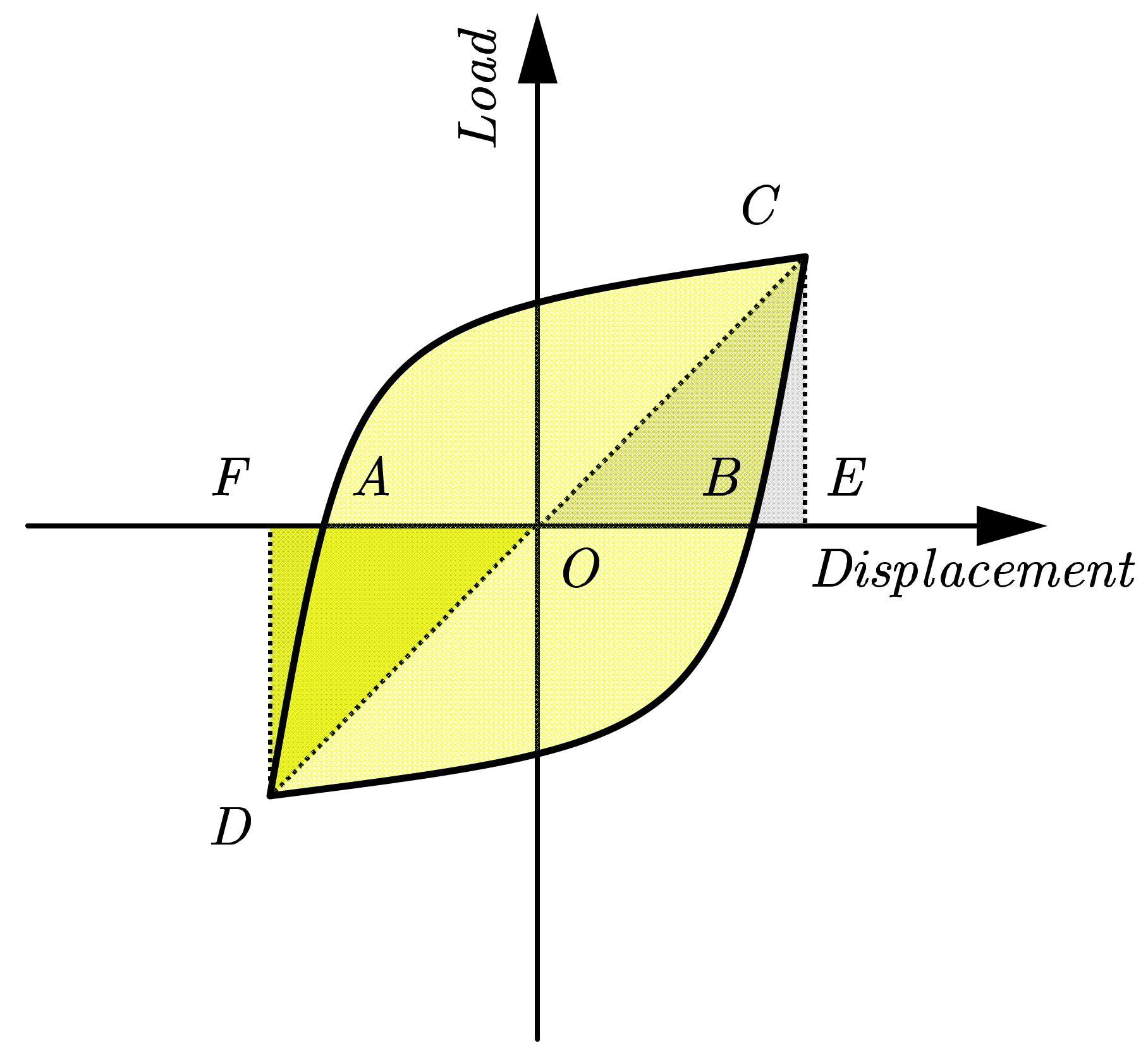
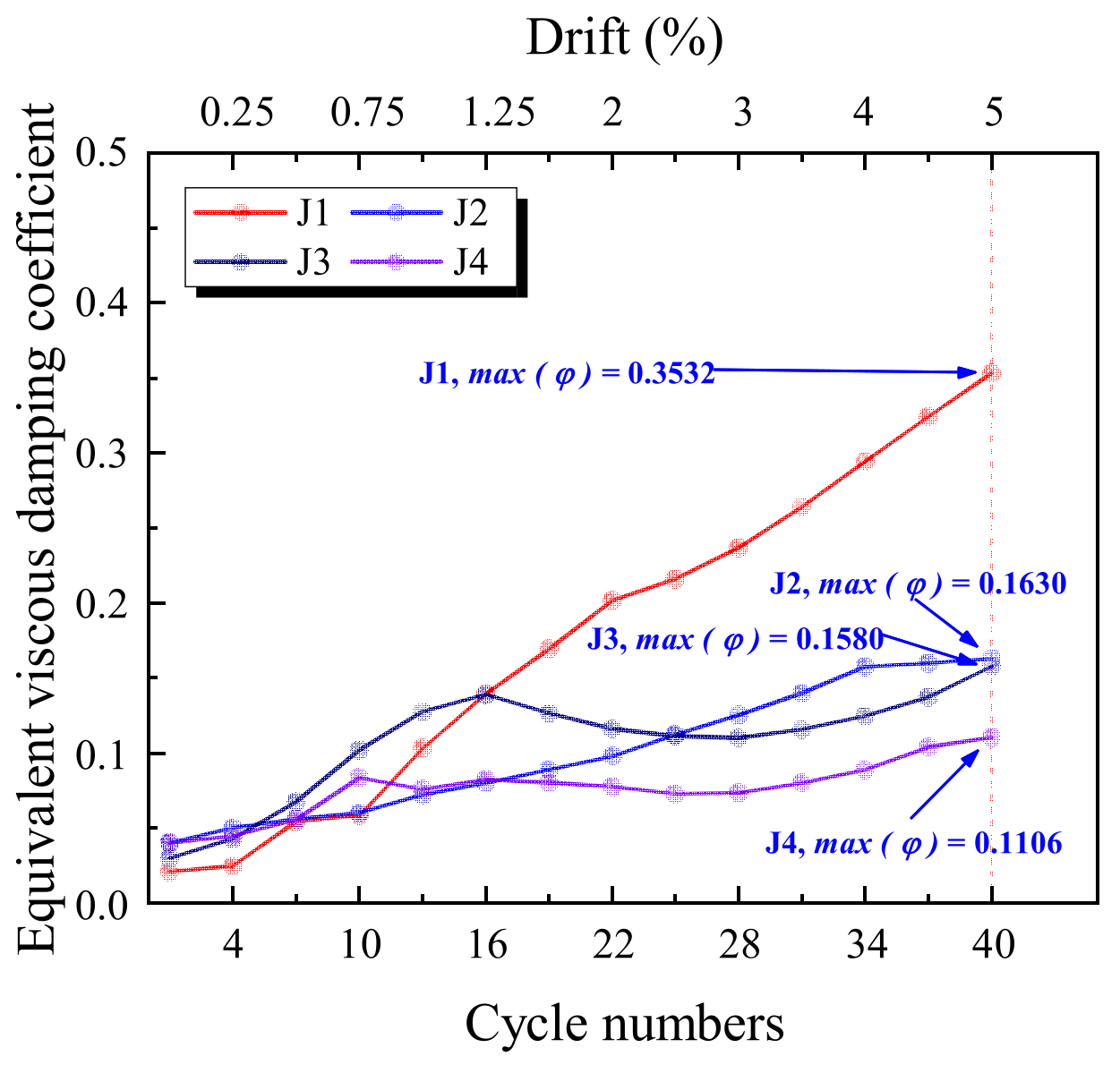
6. Conclusions
- (1)
- Component construction: This structure has a simple form and a clear force path. The material properties of the connecting steel plates are changed to optimize the seismic performance of the joints, and the performance repair after structural damage can be achieved by replacing the connecting steel plates. There is no wet work in the assembly process, and all-dry construction and assembly methods are used. During construction, only the beams and columns need to be assembled by high-strength bolts. There is no need to pour concrete and support formwork, which significantly improves construction efficiency, reflecting the convenience and efficiency of dry connection construction;
- (2)
- Failure mode: This paper observes and analyzes the failure mode of the PBSEC joints, the buckling failure of the connecting steel plate, which is the ideal failure mode. When the structure is subjected to earthquake action, the connecting steel plate of the joint resists the bending moment brought by the earthquake action, resulting in damage while the beam and column are still in an elastic state. When the connecting steel plate of the joint yields further and buckles, the stiffness of the joint changes from the semi-rigid feature to zero, which can be regarded as a hinge. The structure is in the ideal state when the beam end is hinged, and the seismic capacity and collapse resistance of the structure is obtained;
- (3)
- Seismic performance: The hysteresis curves of the PBSEC joints do not have slip characteristics. They are bow-shaped and full in shape, showing high energy dissipation capacity. The bearing capacity of the joints begins to rise rapidly at the initial loading stage and then decreases slowly after reaching the peak, which is an ideal shape. By summarizing the average peak load, strength degradation coefficient, loop energy per cycle, loop energy per level, cumulative energy and equivalent viscous damping coefficient, it is found that the energy dissipation capacity of joint J1-235-10 is better than other joints, reflecting its excellent energy dissipation performance, indicating that the joint using 10 mm thick Q235 steel can obtain the most suitable failure mode and obtain the best energy dissipation performance. When the strength of the steel plate material increases, the energy dissipation performance of the joint drops.
Author Contributions
Funding
Data Availability Statement
Conflicts of Interest
References
- Priestley, M.J.N.; Tao, J.R. Seismic Response of Precast Prestressed Concrete Frames with Partially Debonded Tendons. PCI J. 1993, 38, 58–69. [Google Scholar] [CrossRef]
- Priestley, M.J.N.; Macrae, G.A. Seismic Tests of Precast Beam-to-Column Joint Subassemblages With Unbonded Tendons. PCI J. 1996, 41, 64–81. [Google Scholar] [CrossRef]
- Englekirk, R.E. Development and Testing of a Ductile Connector for Assembling Precast Concrete Beams and Columns. PCI J. 1995, 40, 36–51. [Google Scholar] [CrossRef]
- Guo, T.; Xu, Z.; Song, L.; Wang, L.; Zhang, Z. Seismic resilience upgrade of RC frame building using self-centering concrete walls with distributed friction devices. J. Struct. Eng. 2017, 143, 4017160. [Google Scholar] [CrossRef]
- Wang, C.; Liu, Y.; Zheng, X.; Wu, J. Experimental investigation of a precast concrete connection with all-steel bamboo-shaped energy dissipaters. Eng. Struct. 2019, 178, 298–308. [Google Scholar] [CrossRef]
- Wang, C.; Liu, Y.; Zhou, L. Experimental and numerical studies on hysteretic behavior of all-steel bamboo-shaped energy dissipaters. Eng. Struct. 2018, 165, 38–49. [Google Scholar] [CrossRef]
- Cosgun, T.; Cosgun, C.; Kanishka, A.; Mangir, A.; Sayin, B.; Murat Türk, A. Seismic load tests on exterior beam-column connections of existing RC structures. Građevinar 2019, 71, 1129–1141. [Google Scholar]
- Cheok, G.S.; Stone, W.C.; Kunnath, S.K. Seismic Response of Precast Concrete Frames with Hybrid Connections. Aci. Struct. J. 1998, 95, 527–539. [Google Scholar]
- Morgen, B.G.; Kurama, Y.C. Seismic Design of Friction-Damped Precast Concrete Frame Structures. J. Struct. Eng. 2007, 133, 1501–1511. [Google Scholar] [CrossRef]
- Huang, L.; Zhou, Z.; Zhang, Z.; Huang, X. Seismic Performance and Fragility Analyses of Self-Centering Prestressed Concrete Frames with Infill Walls. J. Earthq. Eng. 2021, 25, 535–565. [Google Scholar] [CrossRef]
- Cao, X.; Xiong, C.; Feng, D.; Wu, G. Dynamic and probabilistic seismic performance assessment of precast prestressed reinforced concrete frames incorporating slab influence through three-dimensional spatial model. B. Earthq. Eng. 2022, 20, 6705–6739. [Google Scholar] [CrossRef]
- Cao, X.; Feng, D.; Wang, Z.; Wu, G. Parametric investigation of the assembled bolt-connected buckling-restrained brace and performance evaluation of its application into structural retrofit. J. Build. Eng. 2022, 48, 103988. [Google Scholar] [CrossRef]
- Cao, X.; Shen, D.; Feng, D.; Wang, C.; Qu, Z.; Wu, G. Seismic retrofitting of existing frame buildings through externally attached sub-structures: State of the art review and future perspectives. J. Build. Eng. 2022, 57, 104904. [Google Scholar] [CrossRef]
- Wang, C.; Usami, T.; Funayama, J.; Imase, F. Low-cycle fatigue testing of extruded aluminium alloy buckling-restrained braces. Eng. Struct. 2013, 46, 294–301. [Google Scholar] [CrossRef]
- Ersoy, U.; Tankut, T. Precast concrete members with welded plate connections under reversed cyclic loading. PCI J. 1993, 38, 94–100. [Google Scholar] [CrossRef]
- Ertas, O.; Ozden, S.; Ozturan, T. Ductile Connections in Precast Concrete Moment Resisting Frames. PCI J. 2006, 51, 66–76. [Google Scholar] [CrossRef]
- Kim, J.H.; Cho, Y.S.; Lee, K.H. Structural performance evaluation of circular steel bands for PC column–beam connection. Mag. Concrete Res. 2013, 65, 1377–1384. [Google Scholar] [CrossRef]
- Feng, D.; Wang, Z.; Cao, X.; Wu, G. Damage mechanics-based modeling approaches for cyclic analysis of precast concrete structures: A comparative study. Int. J. Damage Mech. 2020, 29, 965–987. [Google Scholar] [CrossRef]
- Feng, D.; Wu, G.; Lu, Y. Numerical investigation on the progressive collapse behavior of precast reinforced concrete frame subassemblages. J. Perform. Constr. Fac. 2018, 32, 4018027. [Google Scholar] [CrossRef]
- Feng, D.C.; Wang, Z.; Wu, G. Progressive collapse performance analysis of precast reinforced concrete structures. Struct. Des. Tall Spec. Build. 2019, 28, e1588. [Google Scholar] [CrossRef]
- Feng, D.; Wu, G.; Lu, Y. Finite element modelling approach for precast reinforced concrete beam-to-column connections under cyclic loading. Eng. Struct. 2018, 174, 49–66. [Google Scholar] [CrossRef]
- Feng, D.; Xiong, C.; Brunesi, E.; Parisi, F.; Wu, G. Numerical Simulation and Parametric Analysis of Precast Concrete Beam-Slab Assembly Based on Layered Shell Elements. Buildings 2020, 11, 7. [Google Scholar] [CrossRef]
- Brunesi, E.; Nascimbene, R.; Parisi, F.; Augenti, N. Progressive collapse fragility of reinforced concrete framed structures through incremental dynamic analysis. Eng. Struct. 2015, 104, 65–79. [Google Scholar] [CrossRef]
- GB/T 228.1-2010; Metallic Materials-Tensile Testing-Part 1: Method of Test at Room Temperature. Standardization Administration of the People’s Republic of China: Beijing, China, 2010.
- GB/T 50081-2002; Standard for Test Method of Mechanical Properties on Ordinary Concrete. Ministry of Housing and Urban-Rural Development of the People’s Republic of China: Beijing, China, 2002.
- JGJ/T101‐2015; Specification of Testing Methods for Earthquake Resistant Building. Ministry of Housing and Urban-Rural Development of the People’s Republic of China: Beijing, China, 2015.
- Cao, X.; Wu, G.; Feng, D.; Zu, X. Experimental and numerical study of outside strengthening with precast bolt-connected steel plate–reinforced concrete frame-brace. J. Perform. Constr. Fac. 2019, 33, 4019077. [Google Scholar] [CrossRef]
- Fan, J.; Wu, G.; Feng, D.; Zeng, Y.; Lu, Y. Seismic performance of a novel self-sustaining beam-column connection for precast concrete moment-resisting frames. Eng. Struct. 2020, 222, 111096. [Google Scholar] [CrossRef]
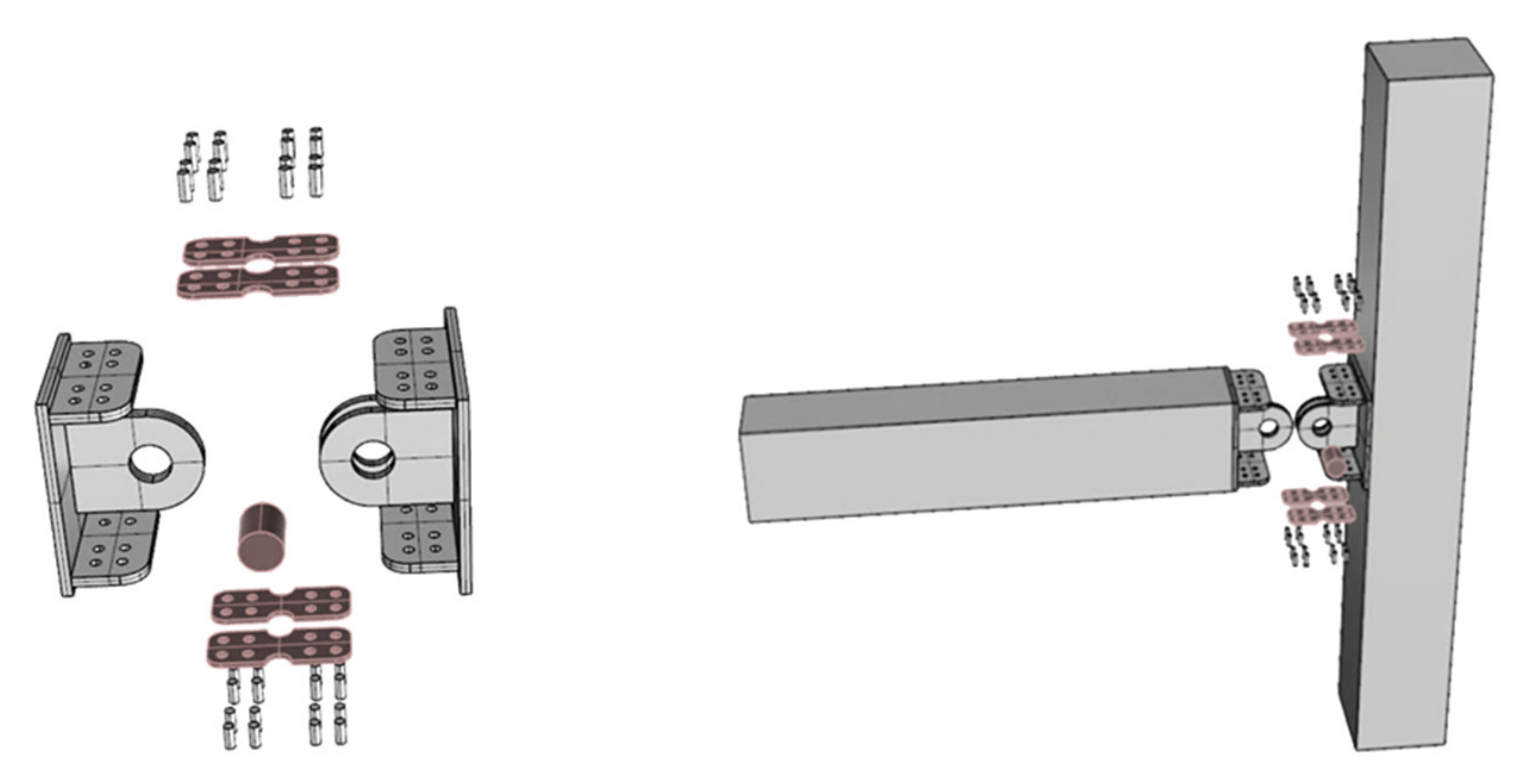
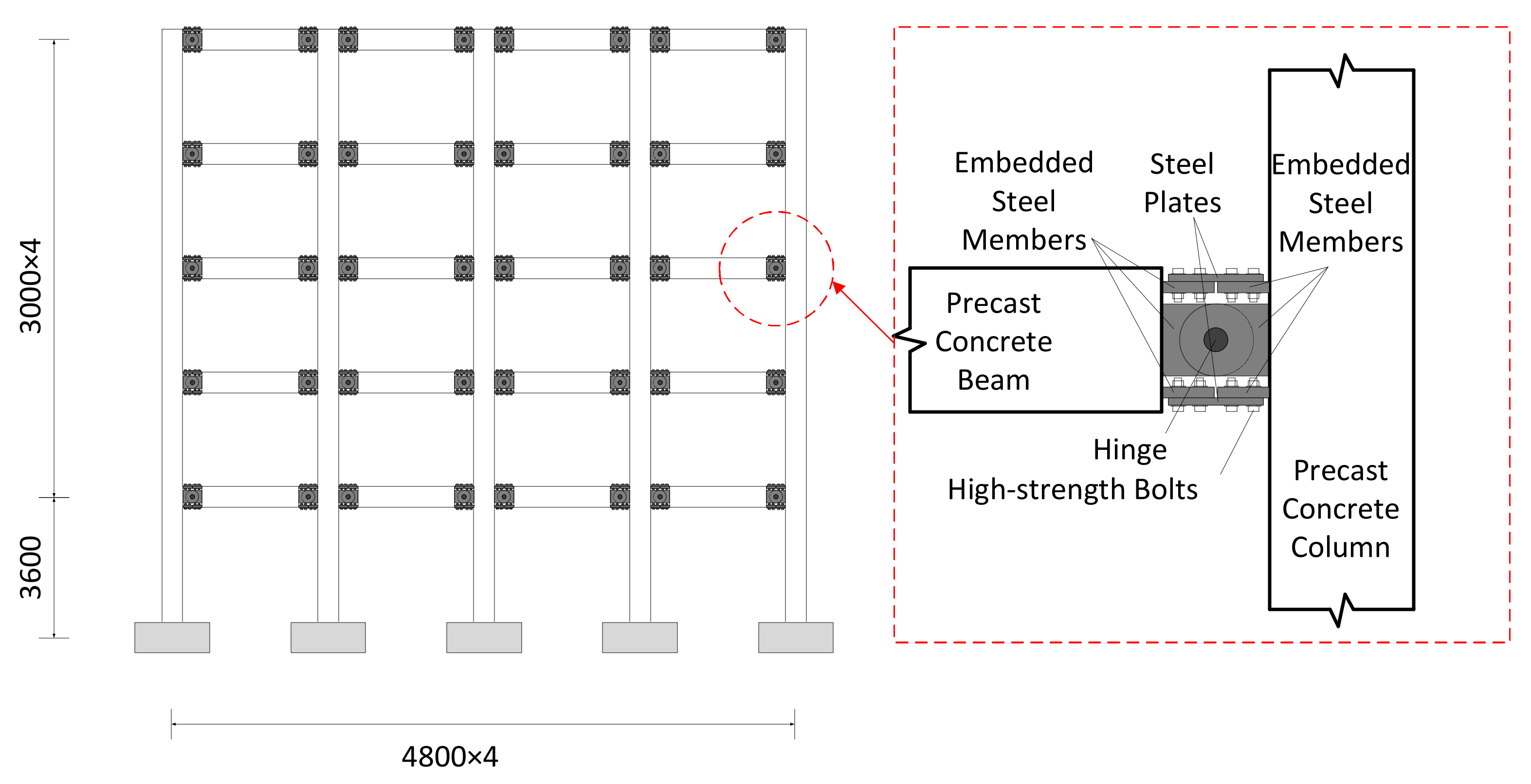




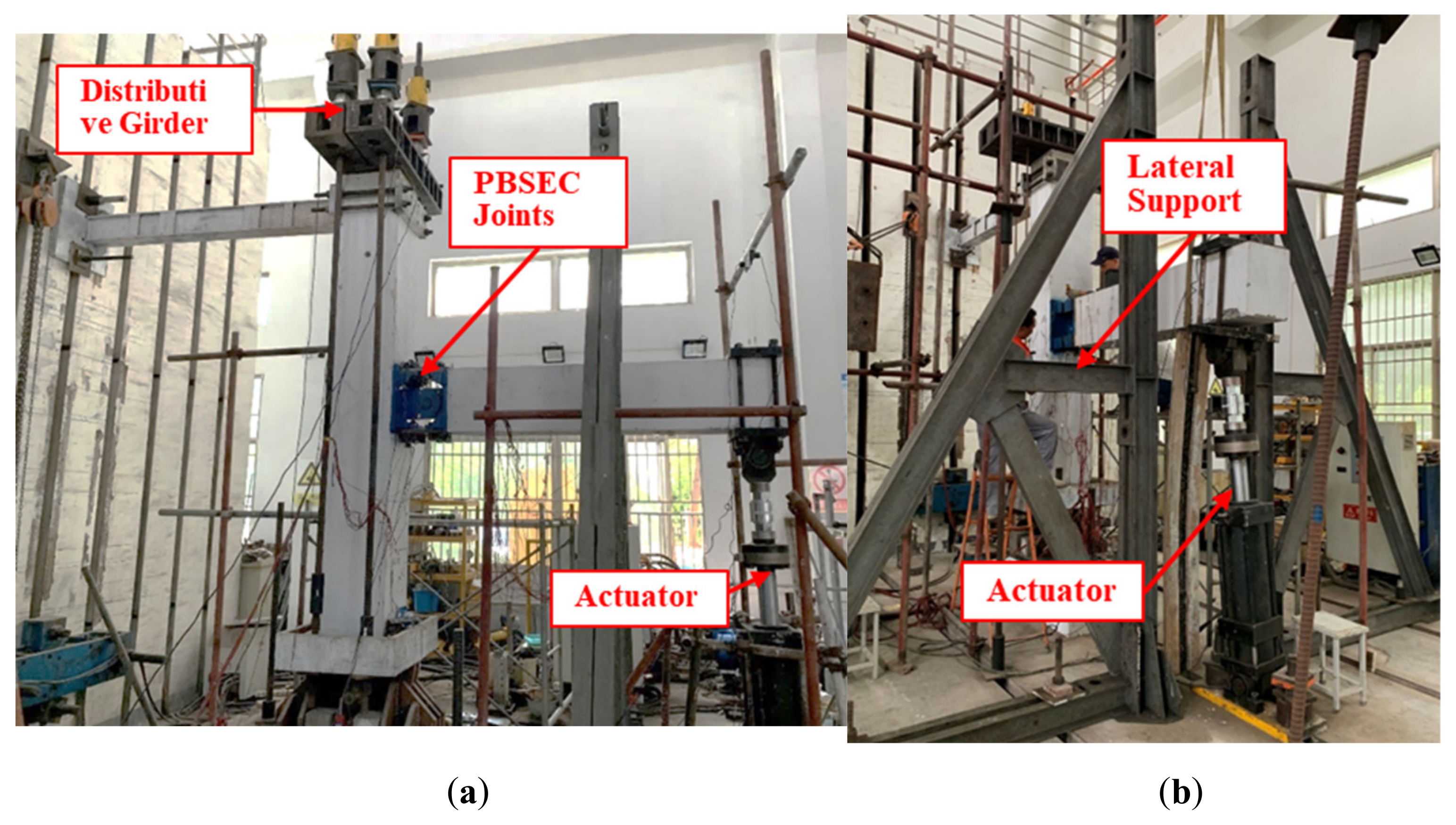

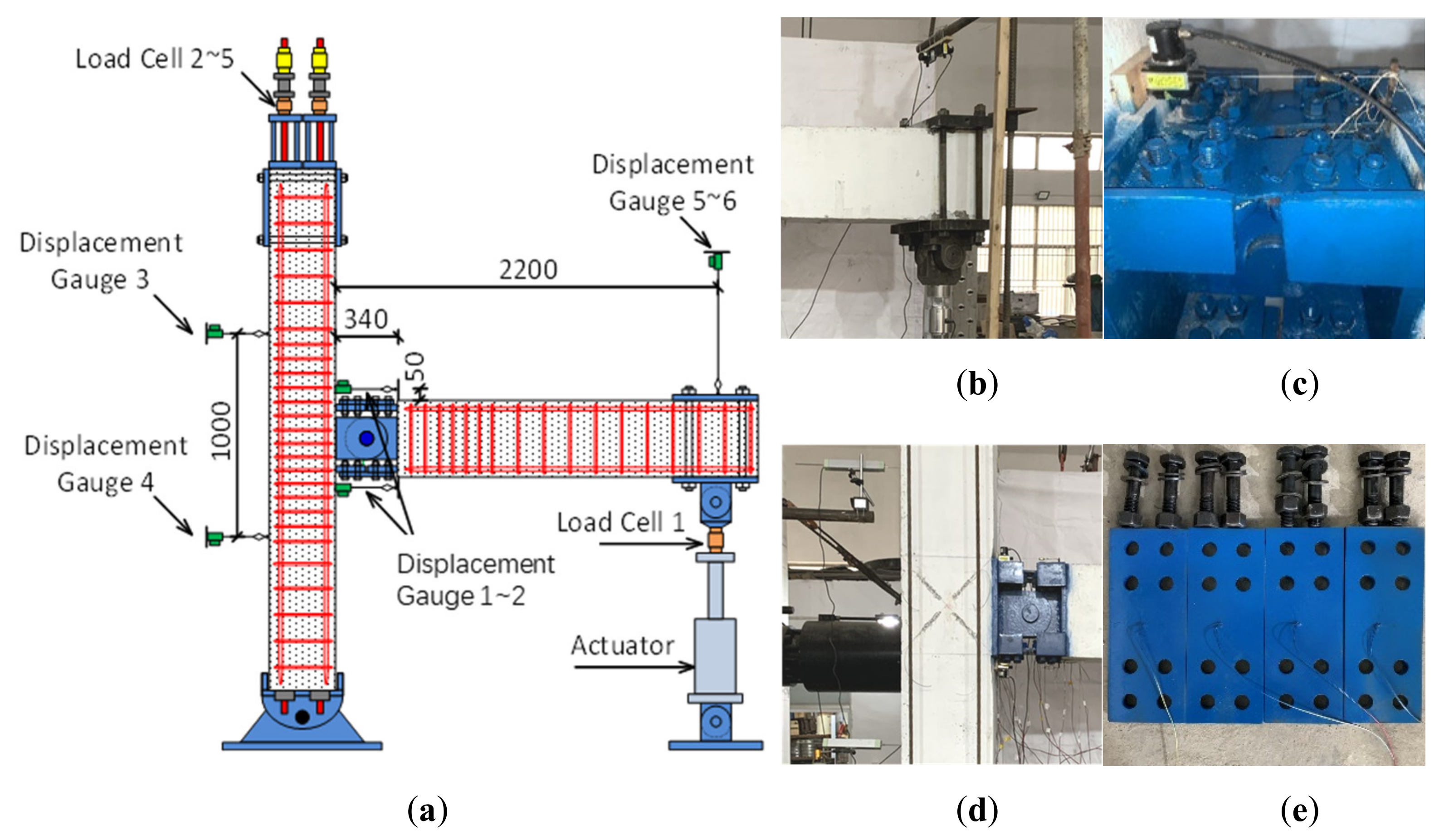
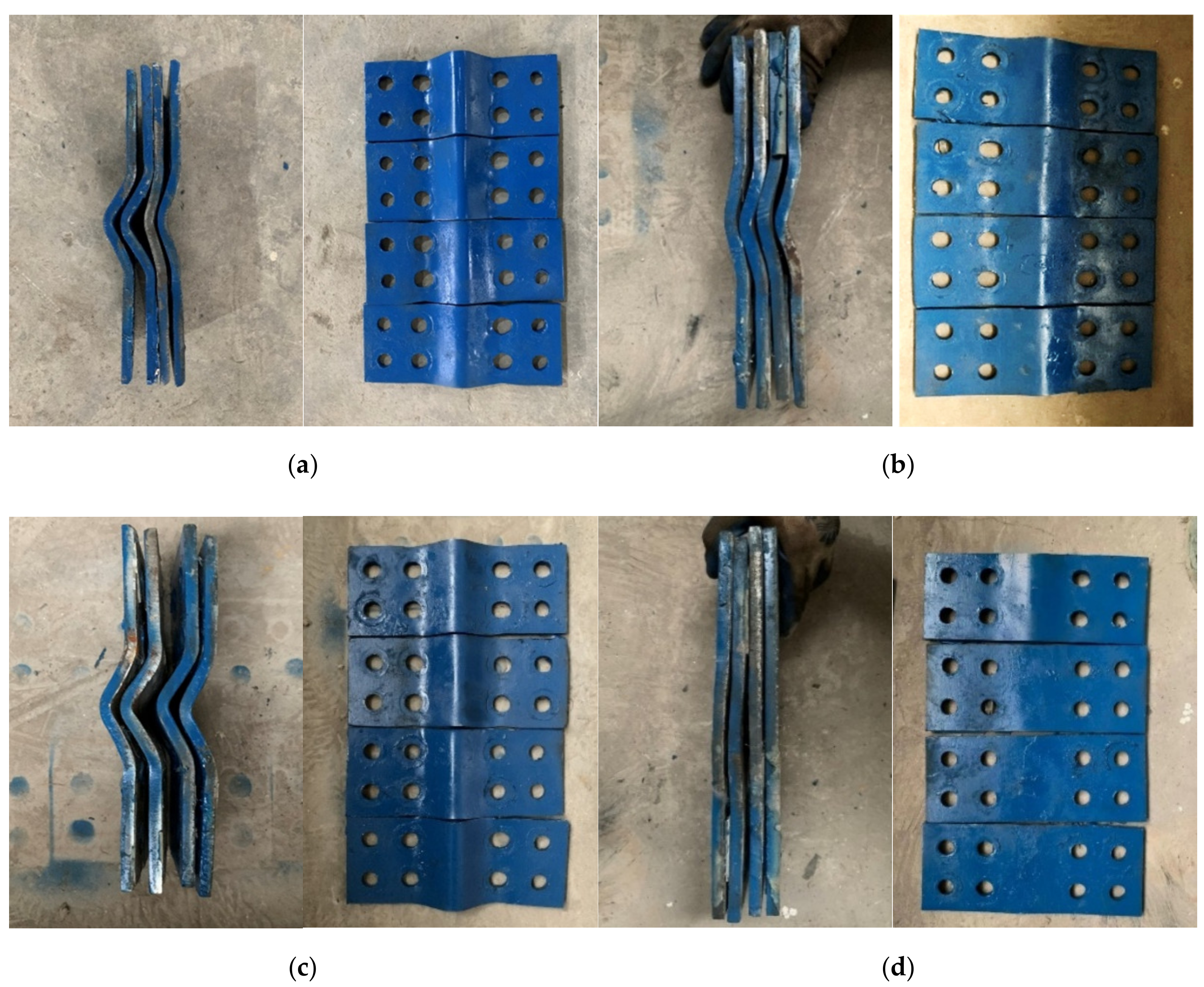
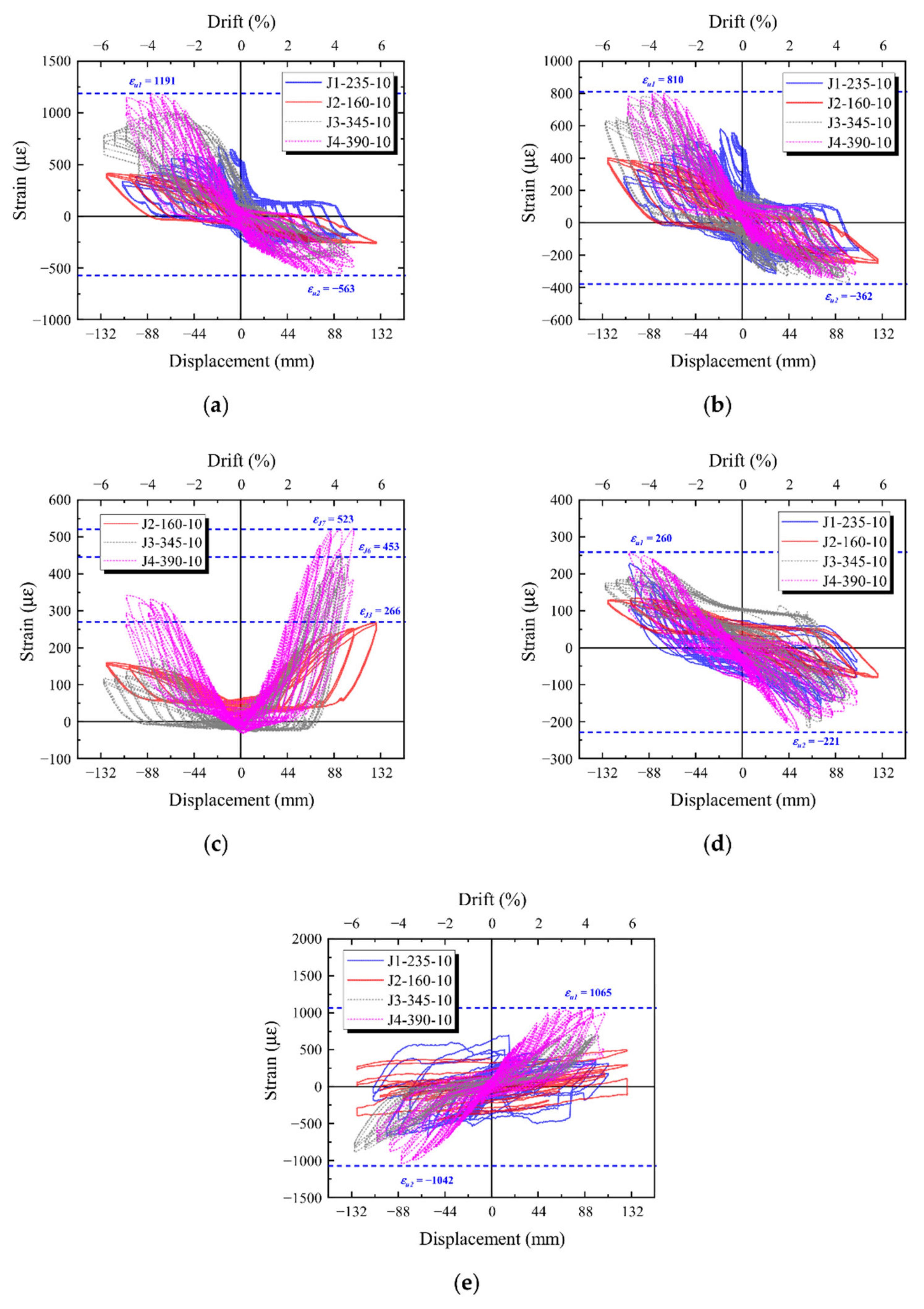
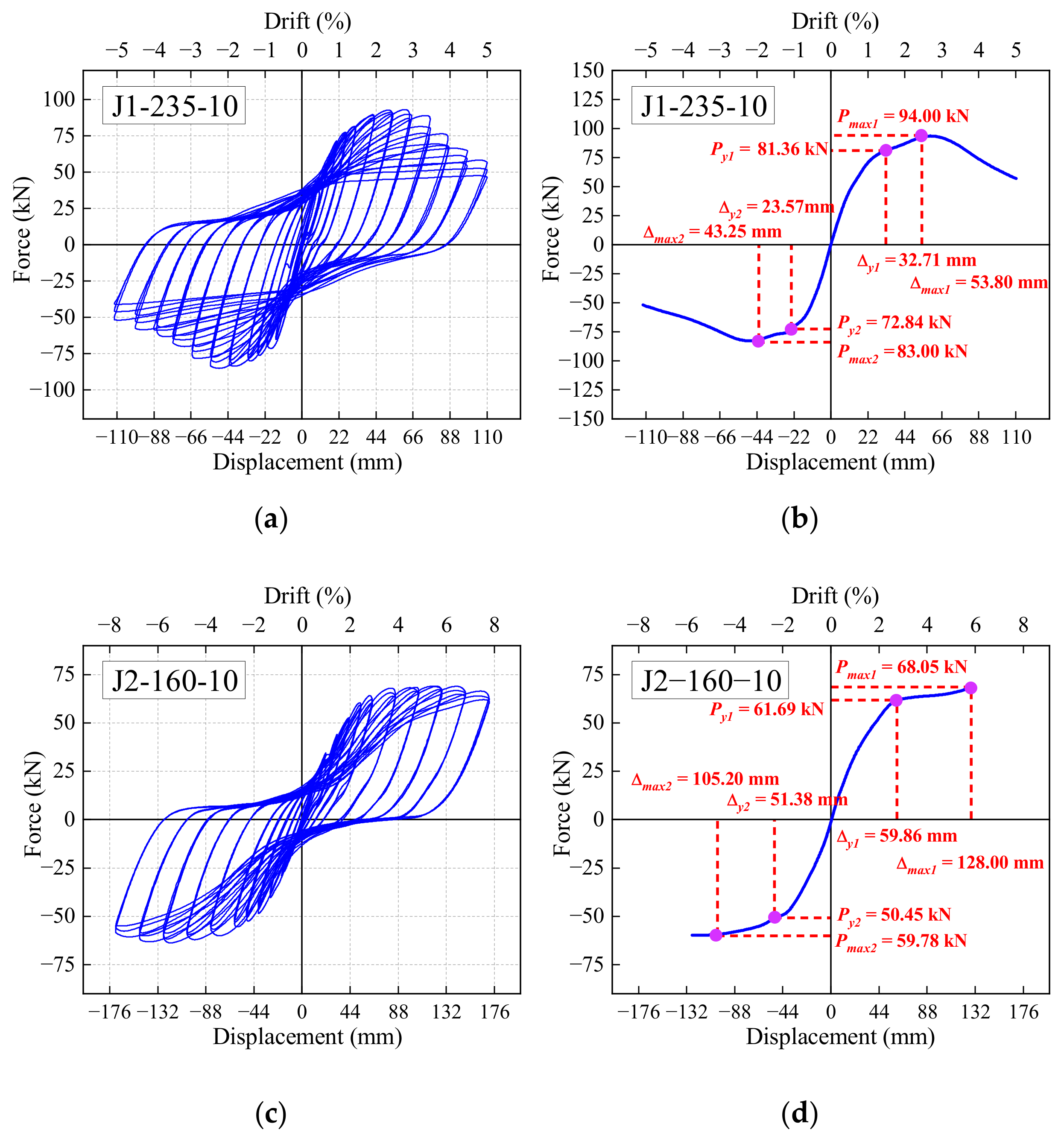

| Specimen No. | Steel Strength | Steel Section/mm | Test Parameters |
|---|---|---|---|
| J1-235-10 | Q235 | 280 × 110 × 10 | Control group |
| J2-160-10 | LY160 | 280 × 110 × 10 | Decrease the strength |
| J3-345-10 | Q345 | 280 × 110 × 10 | Increase the strength |
| J4-390-10 | Q390 | 280 × 110 × 10 | Increase the strength |
| Grade | Diameter (mm) | fy (MPa) | fu (MPa) | Es (Gpa) |
|---|---|---|---|---|
| HRB500 | 10 | 552 | 756 | 201 |
| HRB500 | 28 | 548 | 750 | 208 |
| Grade | f7d (MPa) | f28d (Mpa) | fc (MPa) | Ec (Gpa) |
|---|---|---|---|---|
| C50 | 39.5 | 50.7 | 37.9 | 30.5 |
| Grade | fy (MPa) | εy | fu (MPa) | εu |
|---|---|---|---|---|
| LY160 | 178.3 | 0.01959 | 316.4 | 0.26549 |
| Q235 | 311.4 | 0.02069 | 408.9 | 0.18001 |
| Q345 | 408.0 | 0.02173 | 562.3 | 0.17039 |
| Q390 | 429.0 | 0.02043 | 549.0 | 0.16590 |
| Specimens | Directions | Py (kN) | Δy (mm) | Pm (kN) | Δm (mm) | Δu (mm) |
|---|---|---|---|---|---|---|
| J1-235-10 | positive | 81.36 | 32.71 | 94.00 | 53.80 | 81.94 |
| negative | −72.84 | −23.57 | −83.00 | −43.25 | −72.71 | |
| J2-160-10 | positive | 61.69 | 59.86 | 68.05 | 128.00 | N/A |
| negative | −50.45 | −51.38 | −59.78 | −105.20 | N/A | |
| J3-345-10 | positive | 115.55 | 68.83 | 126.56 | 99.00 | 119.69 |
| negative | −106.67 | −52.09 | −121.79 | −73.45 | −120.39 | |
| J4-390-10 | positive | 120.39 | 72.05 | 130.70 | 95.50 | N/A |
| negative | −113.99 | −52.24 | −127.52 | −74.17 | N/A |
Publisher’s Note: MDPI stays neutral with regard to jurisdictional claims in published maps and institutional affiliations. |
© 2022 by the authors. Licensee MDPI, Basel, Switzerland. This article is an open access article distributed under the terms and conditions of the Creative Commons Attribution (CC BY) license (https://creativecommons.org/licenses/by/4.0/).
Share and Cite
Wang, Z.; Feng, D.-C.; Wu, G. Experimental Study on Seismic Behavior of Precast Bolt-Connected Steel-Members End-Embedded Concrete (PBSEC) Beam-Column Connections. Buildings 2022, 12, 1652. https://doi.org/10.3390/buildings12101652
Wang Z, Feng D-C, Wu G. Experimental Study on Seismic Behavior of Precast Bolt-Connected Steel-Members End-Embedded Concrete (PBSEC) Beam-Column Connections. Buildings. 2022; 12(10):1652. https://doi.org/10.3390/buildings12101652
Chicago/Turabian StyleWang, Zhun, De-Cheng Feng, and Gang Wu. 2022. "Experimental Study on Seismic Behavior of Precast Bolt-Connected Steel-Members End-Embedded Concrete (PBSEC) Beam-Column Connections" Buildings 12, no. 10: 1652. https://doi.org/10.3390/buildings12101652
APA StyleWang, Z., Feng, D.-C., & Wu, G. (2022). Experimental Study on Seismic Behavior of Precast Bolt-Connected Steel-Members End-Embedded Concrete (PBSEC) Beam-Column Connections. Buildings, 12(10), 1652. https://doi.org/10.3390/buildings12101652







